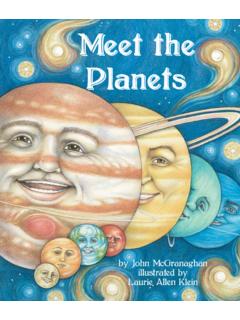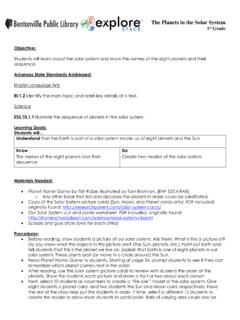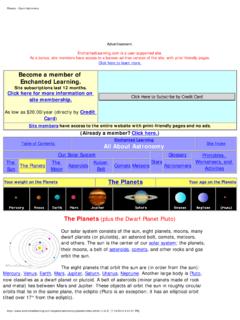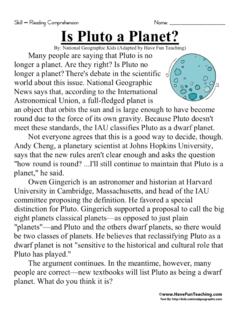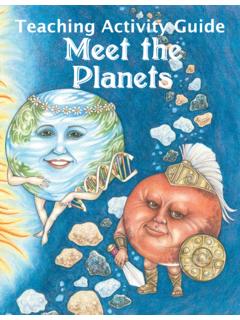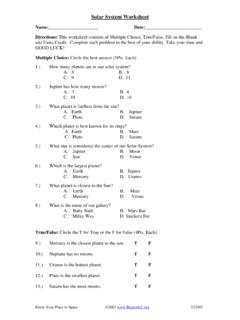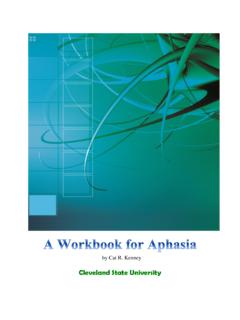Transcription of THIRD GRADE - msnucleus.org
1 THIRD GRADE1 WEEK LESSON PLANS AND ACTIVITIESMath/Science Nucleus 1990, 20012 UNIVERSE CYCLEOVERVIEW OF THIRD GRADE UNIVERSEWEEK 1. PRE: Contrasting different components of the Universe. LAB: Comparing and contrasting stars. POST: Comparing relative and absolute SYSTEMWEEK 2. PRE: Distinguishing between revolution and rotation. LAB: Discovering the terrestrial : Investigating the gas giants. EARTHWEEK 3. PRE: Comparing lunar and solar : Discovering how landforms are created on Earth. POST: Exploring the reasons for seasons. GEOGRAPHYWEEK 4. PRE: Describing different types of maps. LAB: Exploring how to make a map. POST: Comparing maps and globes. Math/Science Nucleus 1990, 20013 Students learn about rotation CYCLE - SOLAR SYSTEM (3)PRE LABOBJECTIVES:1.
2 Describing and comparing motions in our Solar Distinguishing between rotation and :axisorbitrevolutionrotationMATERIALS:wo rksheetSolar System PlacematsBACKGROUND:Students should now be aware of the great movements that occur in the is also present throughout our Solar System. Even the Sun moves within theMilky Way Galaxy! You may want to ask them what evidence suggests to us that the Earthmoves. The rising and setting of the Sun and Moon implies that one of the objects ismoving. The changing positions of the stars, Sun, and Moon also implies movement oflonger occurrence. The key concepts to emphasize are that the Earth revolves around the Sun or orbitsaround a central point. The Earth also rotates on its axis or on itself. Although simple,these terms are easily confused.
3 Use the worksheet to help student example of revolve and rotation is a person who is sitting on a horse attachedto a Ferris wheel. The person in the horse is revolving around the center, however rotationof the horse and person would occur if the person in the horse spins. The Earth, spinningon its axis, revolves around the Sun. The Moon, rotating on its axis, revolves around theEarth. Rotation is a little more involved because students need to understand an axis. Anaxis is an imaginary line around which an object spins on itself. The Earth's axis is animaginary line that runs through the north and south poles. You can use a basketballspinning on a finger as an example of rotation. Rotation causes day and night, and thetilt of the axis (23 ) causes the seasons.
4 The quality of the sunlight caused by thetilting of the axis is the major factor causing the seasons, not the distance from the Nucleus 1990, 20014 PROCEDURE:1. Ask the students what evidence suggests to us that the Earth moves. Explainhow the passing of day and night are cause by rotation. 2. You may want students to work in groups of 4 or 5 and have them illustrate toyou the difference between revolution and rotation. Students should revolve around acentral student, but they should also be rotating on their axis as they revolve. 3. The placemats are a way to get students to learn to observe and collectinformation. The orbit of each planet defines their revolution around the Sun. Point outthe rings around Jupiter, saturn , Uranus, and Neptune to the students.
5 Tell them that therings define the planet s rotation. These objects circle the planet in a band . The planet saxis is perpendicular to this Draw a picture of the orbits using the diagram below as a model. Ask studentsto look closely at the orbits. Point out that the planets revolve in very defined areas, alongthe lines. Tell them the orbits are not wild! The only planet that has an eccentric (a littleon the wild side) orbit is Pluto. Its orbit actually brings Pluto closer to the Sun thanNeptune during some Have the students use the Solar System placemat to help answer the questionson the worksheet. Answers: A = revolves; B = rotates; 1. An axis is an imaginary line through an objectaround which it spins. The point on the axis does not move.
6 2. The Earth revolvesaround the Sun. 3. The Earth rotates on its axis. 4. Yes. The axis points away from theSun as it rotates. 5. The orbits of Mercury through Neptune are flat - they all lie in thesame plane. The orbits of these planets are also almost circular. Pluto is the exception:its orbit is tilted about 20o from the other planets, and it has an elliptical (oval) Nucleus 1990, 20015 UNIVERSE CYCLE - SOLAR SYSTEM (3) HOW DOES OUR EARTH MOVE?revolve = to orbit a central pointrotate = to turn or spin on an axis1. What is an axis? _____2. The Earth _____ around the The Earth _____ on its Does the Earth rotate and revolve at the same time? Does the axis of the Earth move?Explain your Describe and compare the orbits of all of the planets around the Nucleus 1990, 20016 Students make a model of howthe inner planets orbit around planets - Mars, Earth, Venus,Mercury, and PlutoUNIVERSE CYCLE - SOLAR SYSTEM (3)LABOBJECTIVES:1.
7 Discovering the terrestrial Exploring the rotation of the inner planets. VOCABULARY:inner planetsrevolutionrotationterrestrial planetsMATERIALS: brads (very small nails)construction papercompass or circle templates (see below)Solar System PlacematsBACKGROUND: The Solar System consists of our Sun (a star) and an assemblage of smaller bodiesthat revolve around the Sun. The smaller bodies include the planets and their moons,asteroids, comets, and interplanetary major planets, in order of increasing distance from the Sun, are Mercury,Venus, Earth, Mars, Jupiter, saturn , Uranus, Neptune, and Pluto. Scientists commonlydivide these into two groups. The terrestrial planets (also called inner planets), Mercury,Venus, Earth and Mars and the gas planets of Jupiter, saturn , Uranus, and is considered a terrestrial planet, but not an inner planet.
8 Moons, or natural satellites, are bodies that revolve around a planet. The Earth hasone moon, while the other planets have none to many. Moons havevarying compositions. The Earth s Moon is essentially rock. Othermoons, particularly those of Jupiter and saturn , appear to haverocky cores, but are surrounded by gaseous are small bodies of rock and frozen gas. They tendto be concentrated in a belt between the orbits of Mars and asteroids also orbit the Sun, on paths that cross the Earth sorbit. These objects began in the asteroid belt, but were pushed intoorbit around the Sun by the gravitational effects of Jupiter, orMath/Science Nucleus 1990, 20017 MercuryMarscollisions with other asteroids. Meteors or "shooting stars" refers toflashes of light that dart across the night sky.
9 These occur when anasteroid enters the Earth s atmosphere and burns up. A comet is a small body composed of frozen gas and smallamounts of rock. Comets are leftovers from the formation of theSolar System. Most comets reside in a belt outside the orbit ofPluto., or much further away in a huge shell surrounding the SolarSystem. Comets travel inward toward the Sun, developing ellipticalorbits. As a comet approaches the Sun, solar radiation heats it gas and dust form the comet s is the closest planet to the Sun. It orbits the Sun quickly, once every 88days. Because it is so close to the Sun, it is difficult to see. Mercury s orbit is veryelliptical, ranging from 46-70 million km from the Sun. It rotates slowly once every 59 Sun appears times larger from Mercury than it does from Earth.
10 Surface rocksfacing the Sun roast to 400 C while the long night surface cools to -170 C. Mercury issmall, about 4850 kilometers (~3000 miles) in diameter. The surface of Mercury looks likethe Moon, but is gray-orange in color. There are many impact craters and large areas oflava, like the Moon's large plains. Venus the second planet away from the Sun, is Earth s closest neighbor. It is aboutthe same size as the Earth, a little over 12,000 kilometers (7300 miles) in diameter. It issometimes considered to be the Earth s twin. Venus rotates counterclockwise once every242 days. This is opposite to all the all other planets. Venus has a very thick atmosphere,composed largely of sulphuric acid and CO2. The surface temperature of Venus has beenrecorded as high as 475 C, which is hotter than Mercury.









